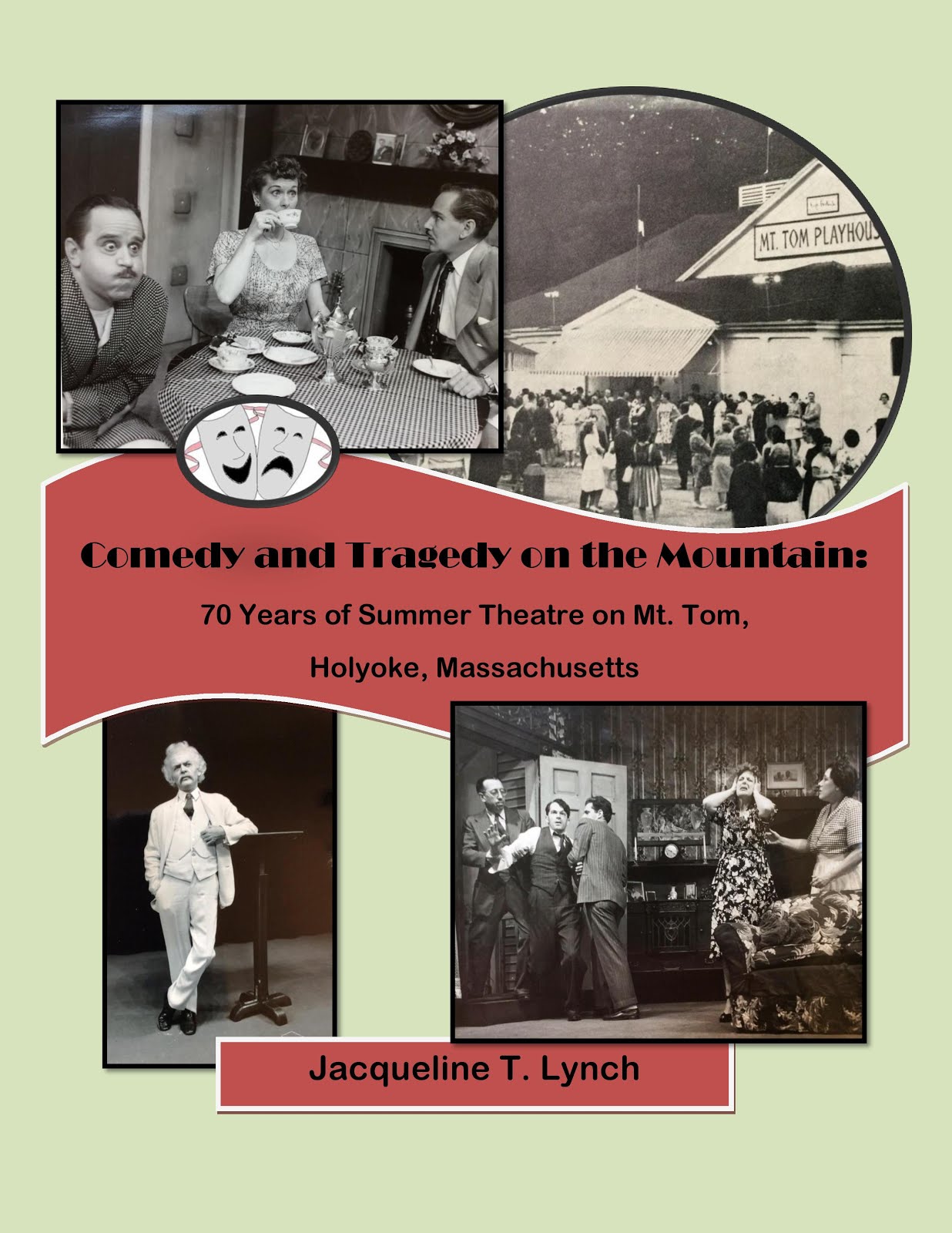
Above is a photo of the paving stones in the historic district of New Bedford, Mass. Soon, for all of us New Englanders, the potholes that grow in the spring (tra-la) will soon make their annual appearance. But not here. No pliable asphalt that stretches and groans over the freezing ground as it contracts. These cobblestones just sit there, and dare anything to change them.
Friday, January 30, 2009
New Bedford's Cobblestones
Posted by
Jacqueline T. Lynch
at
7:33 AM
0
comments
![]()
Labels: 19th century, 21st Century, Massachusetts
Tuesday, January 27, 2009
Vintage Mt. Tom

The above photo shows us a snowy Easthampton, Massachusetts looking down from Mt. Tom.
Mt. Tom, is supposedly named for the surveyor Rowland Thomas, who named the tree-shaggy basalt mountain after himself in the 1600s. You can drive up Mountain Road now, unless bad weather makes it impassible, but the summit wasn’t really easily assessable until 1897 when the Mt. Tom Railroad hauled adventurous passengers up to the Mt. Tom Hotel at the summit on the cable electric trolley. The hotel burned down, for the second time, in 1929 and was never rebuilt. In the vintage postcard below, we see one of the cars was named the “Rowland Thomas” for Mt. Tom’s namesake.
Still further below is another vintage postcard of the mountain from Hendrick Street on the Easthampton side. Both these two postcards were produced by Raphael Tuck & Sons, publishers in Great Britain from the mid-19th to the early 20th centuries. They were granted a Royal Warrant by Queen Victoria in 1893. The following year, they began to publish picture postcards, and 1900, opened an office in New York City. Most of their postcards of American scenes, including these two, were actually printed in Germany, then brought back to the US for sale. Both these cards are likely turn of the century.
This website posts an interesting history of Raphael & Tuck, and notes that all the original records and postcards of this company were destroyed in the bombing of London during World War II.
For more vintage photos of Mt. Tom and the railway, have a look at this website.
Posted by
Jacqueline T. Lynch
at
7:20 AM
0
comments
![]()
Labels: 19th century, 20th Century, Massachusetts, mountains, tourism
Friday, January 23, 2009
Tragedy and Comedy in New England

Above we see the notice on page three of the Byrne’s Dramatic Times from 124 years ago, Saturday, January 17, 1885 announcing a new play opening in Bangor, Maine.
They play was “Vindicated”, adapted from a novel by local author Charles E. Williams, who as we can see had high hopes of success to take the play on tour.
Below, we see the review of the play the following week in the January 24th edition of the Dramatic Times (which also fell on a Saturday as it does tomorrow). Apparently, the performance didn’t go so well. After “the leading lady went into convulsions of laugher” the rest of the play seemed to go south.

As the unnamed newspaper correspondent reflected, “Truly the life of the dramatic author is not one of the pleasantest.”
Hopefully, author Charles E. Williams went on to more profitable projects.
This post is actually an introduction to my new blog on theatre past and present in New England, called Tragedy and Comedy in New England. I hope you can stop by.
Posted by
Jacqueline T. Lynch
at
7:41 AM
2
comments
![]()
Labels: 19th century, entertainment, Maine
Tuesday, January 20, 2009
Jim Rice - Baseball Hall of Fame

Jim Rice in a photograph from a 1976 Boston Red Sox official scorebook magazine.
Congratulations to Jim Rice of our Boston Red Sox for his election to the Baseball Hall of Fame. The ceremony will take place this coming July in Cooperstown, New York.
Posted by
Jacqueline T. Lynch
at
7:26 AM
4
comments
![]()
Labels: 20th Century, 21st Century, New England, sports
Friday, January 16, 2009
Barnum Museum - Bridgeport, Connecticut

Here is The Barnum Museum of Bridgeport, Connecticut. From its opening in 1893 to the present, this unique museum presents a fascinating picture of American popular history and culture, named for that most fascinating of showmen, P.T. Barnum, who died in 1891.
Though we equate Mr. Barnum with the circus world, he was actually 61 years old before he became involved with the circus. He was, among other things, the founder of the American Museum in New York City in 1842. The Bethel, Connecticut native made his career, and his life, a journey of grasping at opportunity, churning out publicity, and celebrating the possibilities of enterprise in a young and vigorous nation.
Barnum’s American Museum was one of the first such cultural entertainments presented before a still-Puritan-minded America dubious about the worth, or propriety of such exhibits. Here he showcased exhibits of nature, music, art, and history.
Today, the Barnum Museum in Bridgeport carries on in a different America, used to self promotion, culture as entertainment, and more curious than ever. For details on the exhibits, programs, and hours, please see this website. If you’re feeling cabin fever, the Barnum Museum will take you to new places.
Posted by
Jacqueline T. Lynch
at
7:33 AM
0
comments
![]()
Labels: 19th century, Connecticut, museums, tourism
Tuesday, January 13, 2009
Bullseye glass - Nantucket

This window is from a shop on Nantucket, but the unusual pane of glass you see here can be found in many buildings of the early 19th century, and earlier. It’s called crown glass, or bullseye glass, and its pattern is the result of the handmade process used before machine-made glass.
When glass was made, it was blown into a hollow globe, or crown. It was flattened by reheating it and spinning it out into a flat disk, up to several feet, then cut to size. The center, called the bullseye, was used for less expensive windows.
Know a building with bullseye windows? Let us know.
Posted by
Jacqueline T. Lynch
at
7:25 AM
0
comments
![]()
Labels: 19th century, architecture, manufacturing, Massachusetts
Friday, January 9, 2009
Hancock Shaker Village

These photos are from the Hancock Shaker Village in Hancock, Massachusetts. The orderliness and serenity remains even if the Shakers who once lived here do not. A museum since 1961 after the community here closed, Hancock was the third of a total of 19 Shaker communities founded between 1783 and 1836 in New York, New England, Kentucky, Ohio and Indiana.
The Shakers, whose proper name is the United Society of Believers in Christ's Second Appearing reached a population peak in the mid-19th century at about 4,000 to 5,000 members. Today, the Shaker community remains active only at Sabbathday Lake in Maine. 
The Hancock Shaker Village is an excellent resource on the Shakers and on 19th-century rural life. For more information, please have a look at this website.
Been there? Done that? Let us know.
Posted by
Jacqueline T. Lynch
at
7:28 AM
0
comments
![]()
Labels: 19th century, 20th Century, Massachusetts, museums
Tuesday, January 6, 2009
Landing in Connecticut

In the above photo, we see what the ground looks like as we come in for a landing over a snowy Connecticut in the area of Bradley International Airport. In January, 1942, the Army Air Base was named Bradley Field in honor of Lt. Eugene M. Bradley of Oklahoma, who died in a training drill crash.
The airfield was returned to the State of Connecticut after the war, and upon returning to civilian use, Bradley International Airport brought air travel service to the area in 1947.
There’s a lot more air traffic now, and perhaps not so coincidentally, a lot more to look at down below, too.
Posted by
Jacqueline T. Lynch
at
7:49 AM
0
comments
![]()
Labels: 20th Century, Connecticut, transportation, World War II
Friday, January 2, 2009
Taking the High Road to Scotland

The names of the towns on this sign remind us of the influence of the British Isles on the much contested hunk of geography that came to be called New England. Scotland, Connecticut, for one, was settled first in 1700 when Isaac Magoon bought land, and in 1857 the Town of Scotland was incorporated.
You don't need to travel to the original Scotland for a highland fling. Scotland, Connecticut hosts its Highland Festival every Columbus Day weekend. Isaac Magoon might not even be able to tell the difference.
For more on Scotland, Connecticut, have a look at this website.
Posted by
Jacqueline T. Lynch
at
8:02 AM
4
comments
![]()
Labels: 18th Century, 19th century, Connecticut, fairs






